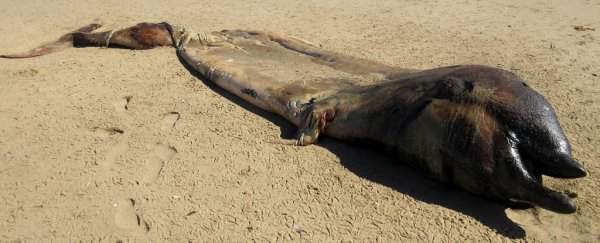Last week the corpse of a mysterious, 6-metre (20-foot) long sea creature washed up in Namibia, confusing experts over whether the remains belonged to a whale or a dolphin.
Scientists have now identified the animal - and it's a unique deep-diving species of whale that hasn't been seen in Namibia since 2000.
After measuring the body and analysing its head shape, researchers are confident that the creature is a Cuvier's beaked whale (Ziphius cavirostris).
The only member of the Ziphius genus, the species is the most commonly sited beaked whale, but it hasn't been seen in Namibia since 2000, according to Simon Elwen, a investigator with the Namibian Dolphin project.
"I was quite surprised," Elwen told the Daily Mail. "These animals are rarely seen in the water, so to see them on land is very unique.
Despite not being seen often, Cuvier's beaked whales are actually incredibly common. On the IUCN Red List of Threatened Species they're listed as of "least concern" and it's believed there are around 100,000 of them living in oceans all across the world.
They can grow up to 7 metres long (23 feet) and weigh up to 3,090 kg (6,800 pounds), and they're easy to distinguish in life by their trademark slanted jawline that makes them look as though they're always smiling.
 (Cetacean Research & Rescue Unit)
(Cetacean Research & Rescue Unit)
The reason they're not often sighted is because they can dive incredibly deep - reaching depths of almost 1,000 metres (3,300 feet).
In fact, they currently hold the record for the longest and deepest known mammal dive.
Because they spend so much time in the depths of the ocean, we don't know a huge amount their behaviours or the threats against them.
This particular corpse was too decomposed to determine exactly how it died - it had a broken jawbone but since there were no other injuries on the body the scientists think this could have happened after death.
The team has collected samples from the corpse to try to find out more about the animal's life and death.
